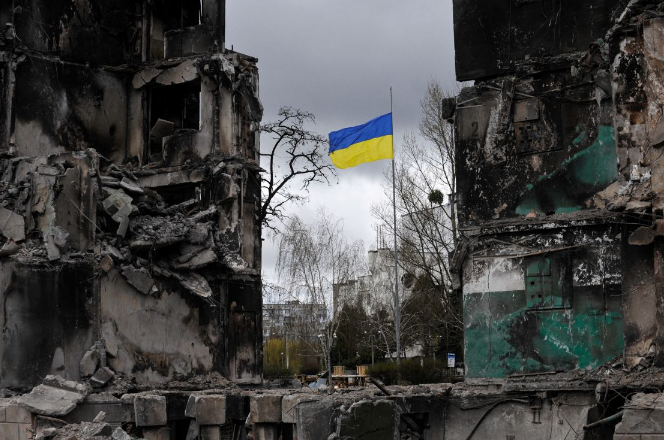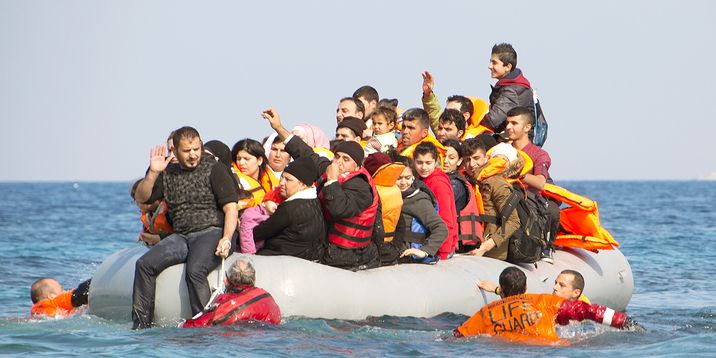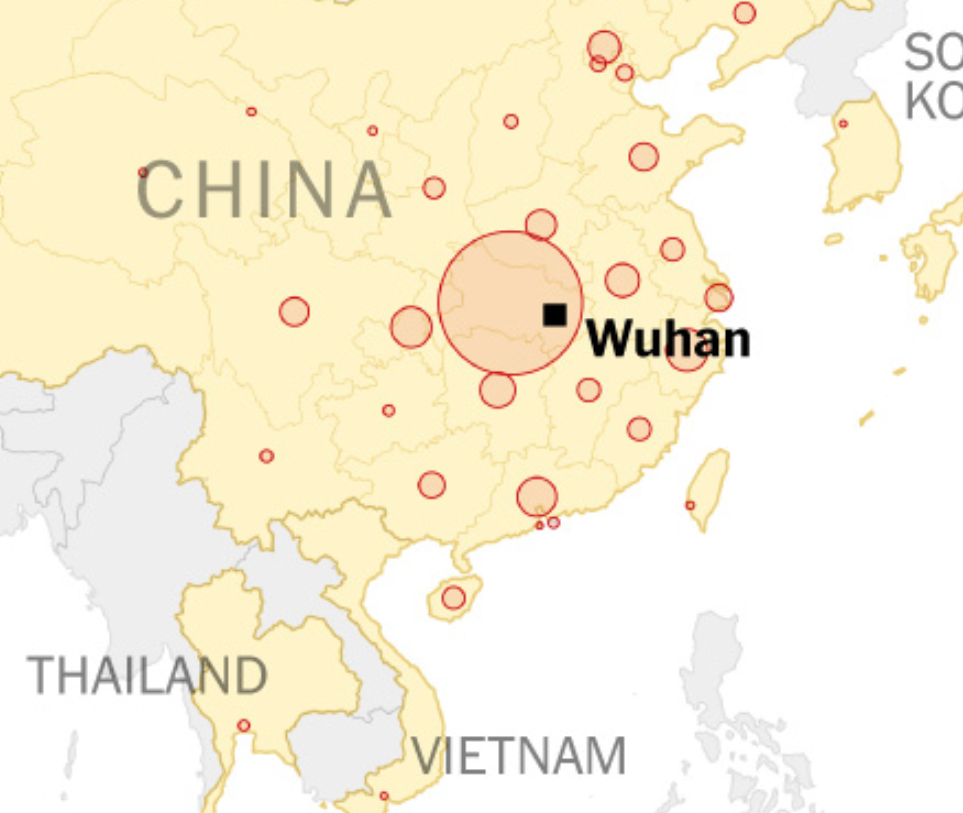By Mariia Bublykova, Year 12
3 years. That is how long had passed since the beginning of the full-scale invasion of Ukraine by Russia on the 24th of February 2022, and almost 11 years since Russian armed forces invaded Ukraine on the 20th of February 2014. Annexing the Crimean peninsula and 2 other regions to the east of Ukraine – Lugansk and Donetsk. And yet despite the ongoing war in Ukraine, taking the lives of people, military, and civilians every single day, the overall interest and exposure in the news outlets keeps decreasing drastically each month.
Number of online news articles mentioning selected keyword combinations related to the Russia-Ukraine war worldwide from 2022 to 2024
And now, as with each passing day, we approach the dark, painful 3rd anniversary of the full-scale invasion, and just 4 days after that the 11th anniversary of Russia’s invasion of Ukraine. It is important as ever to remind us that the war in Ukraine is not over. To remind ourselves of all the lives taken by the war every day, families, lives being destroyed, whole villages and cities wiped off with shillings.
Most of the world first heard about the war in Ukraine in 2022 with the start of the full-scale invasion, though for understanding the nature of the conflict it is important to know how it all started, and the causes of the Russian invasion that took place in 2014. On November 29th, 2013 the now-former president of Ukraine, Viktor Yanukovich known for his close ties with the Russian government and general pro-Russian views refused to sign the Association Agreement and Free Trade Area with the European Union at the Eastern Partnership summit in Vilnius. This resulted in the beginning of manifestations and protests in the country’s capital’s (Kyiv) main square, mostly by the youth and students. The protest was ongoing for more than a month when the president ordered police to break up the gathering, using brute force. The very morning as the capital’s inhabitants witnessed the results of the violent actions of the police and the news outputs started sharing the information. More and more people from all over the country started gathering in the capital, demanding for the violence to be stopped and for the government to comply with the protestors’ demands of returning to the pro-European route the country was previously following and was written in the country’s constitution. As a response, more police and members of the special forces (BERKUT), heavily armed were permitted to use firearms against the unarmed protestors and were sent to the streets. Resulting in even more violence, hundreds wounded, and more than 100 (108) civilians killed. The events were later to be known as the “Revolution of Dignity” shaping significantly and irreversibly Ukraine’s history, modern identity, and political landscape.
Kyiv, the main square “Maidan” during the protest in 2014
During the night from the 21 to the 22 of February 2014, President Yanukovych fled the country heading to Russia, later discovered security footage from the cameras in his mansion showed several truckloads of valuables had been hastily removed from there during the night. Taking advantage of the country’s political instability, Russian armed forces crossed the Ukrainian border on the 20th of February, annexing the Crimean Peninsula. Beginning the invasion of the eastern regions of Ukraine such as Lugansk and Donetsk thus marking the beginning of the Russia-Ukrainian war. For general context, it is important to note that by invading Ukraine, Russia broke the Budapest Memorandum. Known as the Memorandum on Security Assurances in connection with Ukraine’s accession to the Treaty on the Non-Proliferation of Nuclear Weapons signed in 1994 by Ukraine, Russia Great Britain, and the USA, stating that Ukraine agreed to surrender its nuclear arsenal. Which then was the third-largest in the world at the time, and joined the Treaty on the Non-Proliferation of Nuclear Weapons (NPT) as a non-nuclear state. Meanwhile, Russia, the U.S., and the U.K. pledged to respect Ukraine’s sovereignty, independence, and existing borders. For the 8 following years from 2014 to 2022, Russian officials denied their armed presence on the occupied territories of Ukraine, claiming that the armed people were simply “local militia” despite it being disproved numerous times by the Ukrainian government and International institutions. For the following years, most of the time the frontline remained relatively stable, according to the estimates of the UN about 4,400 Ukrainian soldiers were killed from 2014 to 2022. It was only during the winter of 2021-2022 when major relocations of the Russian armed forces were noticed once again near the Ukrainian border masked as “military training”.
On the 24th of February 2022, the full-scale invasion started as Putin declared the “special military operation” aimed at Ukraine’s “denazification, demilitarisation” and “protecting the Russian-speaking people and Russian citizens residing in Ukraine”. As of now, 3 years later the results of Russia’s armed aggression are as visible as ever. As of 2024, Russia occupies almost 20% of Ukraine and about 3 to 3.5 million Ukrainians are estimated to be living under occupation- At least 70,000 Russian troops killed – and an estimated 500,000 being either killed or injured in total, according to the UK Ministry of Defence. According to President Volodymyr Zelensky on Feb. 4., Ukraine has lost 45,100 soldiers on the battlefield since the start of Russia’s full-scale invasion in February 2022. According to another U.N. statistics from the end of 2024, over 12,340 civilian deaths have been recorded in Ukraine since Russia launched its full-scale invasion in February 2022. More than 27,836 Ukrainians were also recorded as wounded during that period, 4 million people are internally displaced, and 6.8 million have fled Ukraine. 14.6 million people need humanitarian assistance. According to the U.N., aerial bombs and long-range weapons caused a greater number of casualties in 2024 than in the previous year, though it is important to note that the statistics vary largely due to the international organizations not having access to the territories under Russian control, or those close to the frontline.
Number of Civilian casualties in Ukraine during Russia’s invasion verified by OHCHR from February 24, 2022, to December 31, 2024
From September 28, 2022, to September 1st, 2024, Russia launched a total of 11,466 missiles. Averaging 26 missiles launched daily. Though in the study period, there were 17 days when missile launches exceeded 82 missiles per day (Only 3% of Russian missiles, drones, and guided bombs hit military targets in Ukraine, while 97% struck civilian infrastructure, Danylo Kubai, Ukraine’s envoy to international organizations in Vienna, said on July 3, 2024).
By the estimates made by the Kyiv School of Economics in April of 2024, the total area of damaged or destroyed facilities by shelling is 88.9 million square meters. Which is 8.6% of the total area of the housing stock of Ukraine, Thus, the housing of about 1.4 million households (about 3.4 million people) is damaged or destroyed.
While reviewing the effects of the war in Ukraine, one of the hardest but most certainly one of the most important themes is the territories currently under the control of Russian armed forces, which was stated earlier in the article, about 3-3.5 million people are living under occupation. It is important to state that in most cases we do not possess enough resources or data regarding the events taking place in those territories as Russia does not allow International organizations to access the occupied cities and villages. The information further used is taken from sources, such as the UN, the UN human rights office of the high commissioner, BBC, CNN, and others, largely relying on stories of survivors who escaped occupation or were liberated from it, and the physical evidence found by the armed forces of Ukraine on the territories liberated from Russian Armed forces control.
The millions of people, mostly civilians who found themselves in the territories controlled by Russian armed forces now live in constant danger. Numerous, if not countless war crimes and human rights violations committed throughout the years. Ever since the territories got under Russian control, the Russian government took numerous steps to ensure their control over the civilian population. On the surface level, the Ukrainian language and symbolics are strictly forbidden, under the threat of persecution, execution, or torture.
Kyiv says about 20,000 children have been taken to Russia or Russian-occupied territory without the consent of family or guardians since the war began, many were forcefully adopted into Russian families, and switched names and birth dates. Making them in most cases almost impossible to be later rediscovered by their remaining family members. Meanwhile, the people remaining in the occupied territories require humanitarian aid they do not receive. Food, water, and medication are extremely scarce if not completely inaccessible for the people. Footages of Russian soldiers dropping bombs from FPV drones onto civilian targets are also sadly not scarce. The fates of those trying to resist the occupation are only worse. In the liberated territories of the Kharkiv oblast, only, 28 torture chambers were discovered, numerous others found in Kyiv, Zaporizdha, Kherson, and other oblasts, many, many still not discovered or not documented, and numerous, in the areas still controlled by Russia, most of them currently functioning. Based on the oral evidence given by the survivors, and the physical evidence collected in the discovered torture chambers in the deoccupied areas provide proof of an organized torture chambers network, often shoving similar if not identical structures, “types” of victims, and methods of torture. Most of the torture chambers discovered so far were organized in ex-police stations, ex-prisons, or in the basements of schools, hospitals, or sometimes residential buildings, mass graves containing bodies featuring evidence of torture are often found nearby. The methods of torture often feature electrocution, food, water and sleep deprivation, beatings, rape, and many others, having short and long-term physical and mental effects on the victims.
As for the Ukrainian prisoners of war, the general picture is not that different, The UK unequivocally condemns the Russian state’s reported systematic torture, abuse, and execution of Ukrainian prisoners of war. According to the UN officials, by some estimates as much as 95 Percent Of Ukrainian Soldiers In Russian Captivity Face Torture. The Ukrainian Prosecutor-General’s Office reports that 147 Ukrainian POWs have been executed by Russian forces since the start of the full-scale invasion. Since August 2024, the Mission documented 79 executions across 24 incidents, with many cases involving soldiers who had surrendered or were otherwise in Russian custody, including instances where unarmed and injured personnel were shot dead on the spot. All of the incidents described above regarding the civil or prisoners of war systematic mistreatment by the armed forces of Russia is admitted to be a violation of the human rights declaration, and only yet another proof of the numerous war crimes committed throughout the war.
In conclusion, especially concerning the recent moves taken by President Trump towards planning a “peaceful agreement” between Ukraine and Russia, I believe it is important to remember that history has shown us numerous times that complying with the aggressor’s demands never leads to its pacifying or satisfaction. One of the most well-known examples of this in modern history is the Treaty of Munich in 1938, which despite allowing Nazi Germany to occupy certain territories of Czechoslovakia. This did not prevent them from continuing their conquest leading to the start of WW2 affected every European country at the time. The Russia-Ukrainian is the biggest war taking place in Europe since WW2, and right now, as much as ever Ukraine needs your support today, as the 3rd anniversary of the full-scale invasion approaches, and fears of the possible outcomes of the “peaceful agreement” arise. It is as important as ever to learn the lessons history has tried to teach us numerous times over and over, to think of what every single compliance to the demands of the Russian government will cost Europe in the future. The results of the peaceful agreements in Ukraine will affect all of Europe, just as the results of the Munich Agreement did, and right now it’s not solely the fate of Ukraine, but the fate of the modern democracy worldwide that is being decided before our eyes. We have to denounce the sufferings brought by the war, recognize the bravery and resilience of the Ukrainian people, to recognize that it is not just a small, local conflict happening somewhere far away, but one that affects all of Europe’s present and future. One that affects every single country and every single person in the world each. That war is closer and much more real than many may think it is, it affects you and your close ones more than you may realize, today and always, Stand with Ukraine.
Bibliography
(some sources may contain sensitive information)
- https://kyivindependent.com/a-very-bloody-war-what-is-the-death-toll-of-russias-war-in-ukraine/
- https://www.csis.org/analysis/assessing-russian-firepower-strikes-ukraine
- https://www.cfr.org/global-conflict-tracker/conflict/conflict-ukraine#:~:text=Fighting%20and%20air%20strikes%20have,million%20people%20need%20humanitarian%20assistance.
- https://www.statista.com/statistics/1344592/russia-ukraine-war-keyword-mentions-in-online-press/
- https://www.statista.com/statistics/1293492/ukraine-war-casualties/
- https://www.reuters.com/world/europe/major-events-russian-invasion-ukraine-2024-06-14/
- https://www.ohchr.org/sites/default/files/documents/countries/ukraine/2024-12-31-pr41-ukraine-en.pdf
- https://www.reuters.com/world/europe/ukraine-strikes-russia-with-massive-drone-atacms-attack-russian-telegram-2025-01-14/
- https://www.ohchr.org/en/statements-and-speeches/2025/01/statement-pablo-de-greiff-commissioner-independent-international
- https://www.ohchr.org/en/press-releases/2024/10/ukraine-torture-russian-authorities-amounts-crimes-against-humanity-says-0
- https://www.betterplace-lab.org/en/wie-verbreitet-russland-desinformation
- https://edition.cnn.com/2023/02/24/europe/ukraine-russia-europe-security-one-year-on-intl-cmd/index.html
- https://www.bbc.com/news/articles/cwyjvkggdnqo
- https://understandingwar.org/backgrounder/russian-offensive-campaign-assessment-february-13-2025
- https://www.hrw.org/news/2023/04/13/ukraine-russian-torture-center-kherson
- https://www.youtube.com/watch?v=AE_45TrZqU8
- https://www.bbc.com/news/world-europe-62970845
- https://www.bbc.com/ukrainian/politics/2013/11/131129_ukraine_eu_assignment_ek
- https://www.youtube.com/watch?v=_5YeX8eCLgA
- https://kyivindependent.com/97-of-russian-missiles-drones-bombs-hit-civilian-infrastructur/
- https://www.bbc.com/news/world-europe-60506682
- https://airwars.org/research/shahed-map/
- https://kse.ua/wp-content/uploads/2024/05/Eng_01.01.24_Damages_Report.pdf
- https://www.france24.com/en/europe/20221205-in-occupied-kherson-the-russians-were-destroying-all-books-in-ukrainian
- https://kyivindependent.com/ukrainian-military-russia-burns-ukrainian-books-in-occupied-luhansk-oblast/
- https://en.kyiv24.news/news/during-the-occupation-of-kherson-region-russians-destroyed-over-200-thousand-ukrainian-books
- https://www.pravda.com.ua/eng/news/2023/02/6/7388039/
- https://kyivindependent.com/how-russia-organized-its-torture-chamber-network-in-kharkiv-oblast/
- https://www.gov.uk/government/speeches/reports-of-russias-treatment-of-ukrainian-prisoners-of-war-are-deeply-concerning-uk-statement-to-the-osce
- https://www.rferl.org/a/ukraine-un-soldiers-torture-russia-95-percent/33070623.html
- https://en.wikipedia.org/wiki/Munich_Agreement
- https://www.lemonde.fr/en/international/article/2025/02/13/trump-launches-ukraine-peace-negotiations-with-putin-shattering-the-allies-unity_6738108_4.html



